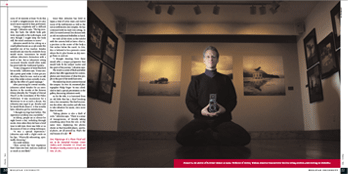A Photographer’s View
 The trip across Japan last summer visiting ancient shrines actually began in Wyoming in the early 1970s. That’s when a high school student named William Johnston came across a book called Essays in Zen Buddhism.
The trip across Japan last summer visiting ancient shrines actually began in Wyoming in the early 1970s. That’s when a high school student named William Johnston came across a book called Essays in Zen Buddhism.
“I was interested in philosophy, in how other cultures in the world answer the big questions we all confront,” says Johnston, now a professor of history.
The search for those answers took Johnston to Japan, where as a young man he began studying Zen. It has since taken him back to that country dozens of times to live or visit there. One of his most recent trips resulted in Zen Pilgrimage of a Photo Thief, a distinctive photography exhibit on display until December 10 at the gallery in Wesleyan’s Mansfield Freeman Center for East Asian Studies.
The exhibit is the marriage of the religion, which Johnston now practices daily, with photography, another of his great loves. The crisp and often stark photographs also illustrate the simple beauty that drew him to Zen.
That attraction began in earnest when Johnston decided to spend his junior year of undergraduate study in Japan. It was a complete immersion experience. His host family spoke no English and Johnston’s Japanese was minimal. The first few weeks were interesting at best.
Johnston was able to communicate, however, that he would like to study Zen. As luck (or was it destiny?) would have it, the mother of Johnston’s host family had a cousin who was married to a Zen priest. A few days later, Johnston stood face to face with Niwa Kensho, a priest in the Soto sect of Zen. He was not quite what Johnston expected.
“He smiled a lot and laughed easily,” Johnston says. “He was small in stature and worked as a Japanese literature teacher at a local school. Not intimidating at all.”
But Johnston soon discovered that the smiling little man’s attitude toward Zen was extremely serious.
“I quickly learned how badly my legs could hurt.”
The Soto sect believes enlightenment comes through sitting?specifically sitting cross-legged, or for some, in the near-kneeling position of seiza. The idea is to sit and keep the body and mind completely still, usually for sessions of 40 minutes at least. To do this in itself is enlightenment. But it’s also much easier aspired to than performed.
“Sitting completely still is difficult enough,” Johnston says. “The leg muscles, the back, the whole body gets tired, especially in the early stages. And even though I might keep the body still, the mind continues to move.”
Johnston would do his sitting on a small pillow known as a zafu under the watchful eye of his teacher. Kensho would note any time his student’s focus would waver. Sometimes he would address Johnston’s distraction with a word or two. But as Johnston’s sitting increased, Kensho would often make his point with the traditional kyosaku.
“It was a long piece of wood that he’d hit me with,” Johnston says. “It was usually a pretty good strike. It does get you to refocus, that’s for sure. And in an odd way, if the strike is done correctly, it actually has the effect of a good massage.”
After practicing for several months, Johnston asked Kensho for an introduction to the monks at the famous Eiheiji (literally, the “Temple of Eternal Peace”) in the mountains of the Fukui Prefecture. It was uncommon for a Westerner to sit in such a shrine, but Johnston was eager to go. Kensho said he would think about it. A few months later, Johnston got his introduction.
“I thought my legs hurt before. The experience at Eiheiji was incredible.”
At Eiheiji, people sat in silence for eight hours a day, including through meals. Even when they did have a brief time to talk later, there was little or no discussion of Zen or sitting technique.
“It was a special experience,” Johnston says with a slight smile on his lips. “Physically exhausting, spiritually cleansing.”
His smile widens.
“They served the best vegetarian food I have ever had. And you could eat as much as you liked.”
Since then Johnston has lived in Japan a total of seven years and visited many of the well-known as well as the not-so-well-known Zen temples. He has continued with his daily Zen sitting. In 2003, he visited several Zen shrines with an old reconditioned Rolleiflex in hand.
He took all the shots in the exhibit with the camera held at hara?that is, a position in the center of the body a few inches below the navel. In Zen, this is believed to be a person’s center where the ki (also known as chi) energy flows in and out.
“I thought shooting from there would offer a unique perspective that would both fit the subject matter and the spirit of the journey,” Johnston says.
The result is a series of black and white photos that offer opportunity for contemplation and observation of what few people in this part of the world have seen.
The exhibit has drawn interest beyond the campus. On Nov. 18, renowned photographer Philip Trager ’56 was scheduled to lead a special presentation in the gallery, discussing Johnston’s work.
As for the title, it is borrowed from an old fable that has a thief breaking into a Zen monastery. The thief encounters the abbot, who smiles and tells him to take whatever he wants, even more than he needs.
“Taking photos is also a theft of sorts,” Johnston says. “There is a sense of transgression, of literally taking something away from the site. At the same time, displaying the photos shows us that beautiful places, spiritual places, are all around us. That’s the real beauty of it all.”

